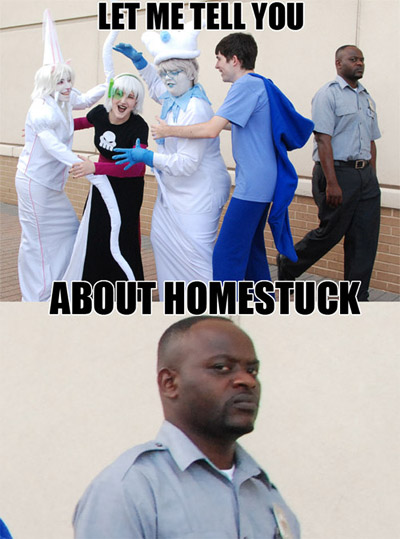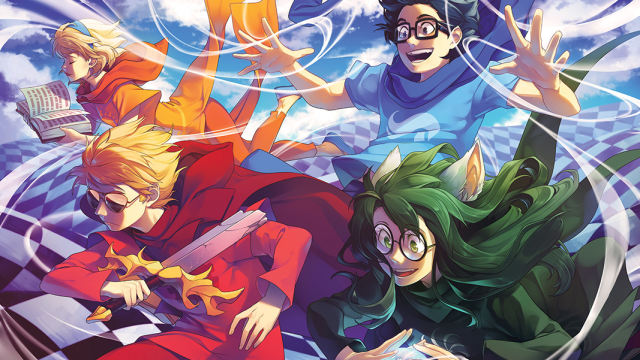Image source: Gina Chacon/Tumblr, Twitter
At long last, the first episode of the Kickstarted Homestuck game, Hiveswap, will be released, only five years after it was originally announced. Homestuck was one of the biggest fandoms of the early 2010s, but what exactly was it? Well, that’s a complicated question.
Before it ended in 2016, Homestuck was a webcomic written and illustrated by Andrew Hussie. Hussie created three other comics prior to Homestuck: Jailbreak, Bardquest and Problem Sleuth.
They were a sort of “choose your own adventure” in which readers would leave suggestions and Hussie would draw new pages based on them. By the end of Problem Sleuth, Hussie was taking more direct control over the story.
“When a story begins to get thousands of suggestions, paradoxically, it becomes much harder to call it truly ‘reader-driven.’ This is simply because there is so much available, the author can cherry-pick from what’s there to suit whatever he might have in mind, whether he’s deliberately planning ahead or not,” Hussie wrote on the page for new readers of his work that’s hosted on his website, MS Paint Adventures.
“But as it happened, I was planning ahead much more as the story neared its end, and I would tend to A) pick commands that suited what I had in mind, or B) just call a spade a spade and outright MAKE UP a command for an idea I had, which I did most often for many of the later attacks.”
Homestuck began shortly after the end of Problem Sleuth, launching on April 13th, 2009. It starts off slow, introducing the initial main characters of John, Dave, Rose and Jade as they play the beta version of fictional simulation game called Sburb.
Homestuck did take some cues from the readership — names of many characters come from reader suggestions — but it was more Hussie’s brainchild than anything else. Before long, it branched off into unexpected places.
A summary made for Hiveswap‘s Kickstarter describes Homestuck as “a story about some kids who are friends over the internet. They decide to play a game together. There are major consequences.”
That’s nominally true, and as good a way as any to summarise the comic’s sprawling plot. You can get about as far as “the kids get stuck in a game” before it becomes incredibly difficult to describe what is happening to them.
They discover dream worlds, fight villains who can stop time, meet grey-skinned alien trolls, discover they’re all related kinda, die and are resurrected. As the comic goes on it becomes exponentially more complex, to the point that even a lot of fans don’t really understand all of it.
By the comic’s end, it was over 8,000 pages long, had hours of animated video, and was less a comic and more a bizarre multimedia project. The imagination and ambition of the project made following it as a fan exciting, and the fandom for Homestuck exploded.

At the height of Homestuck’s popularity, this meme was one of the funniest things I’d ever seen.
Homestuck‘s fandom was particularly creative, especially given the comic’s erratic publishing schedule. Sometimes there would be multiple updates a day, and then Homestuck would go dark for weeks or months. Comic on one of its frequent breaks? Make a browser plug in to tell you when it updates.
Your favourite scene isn’t animated? Learn to do it yourself. Don’t know how to dye your skin grey for a cosplay? There’s a guide for that. The fandom filled Homestuck‘s gaps with derivative works.
Not only are there over 44,000 Homestuck fanfics on fanfiction website Archive of our Own, the community has created several fan albums and animations, and some fanartists created fake stills for an anime.
Not only was the fandom active, it was enormous. When Hussie released a much-anticipated animated update, he opted to host it on Newgrounds for fear of crashing his website.
Nevertheless, the fandom crashed Newgrounds in minutes. The Hiveswap Kickstarter raised over $US2 million, over a million dollars more than its initial request, in 2012.
Anime and comics conventions were awash in kids in grey body paint, casually staining everything they touched.
To people who weren’t into Homestuck, the image of Homestuck fans as a stain is a good way to sum up the problems with the fandom. Homestuck was one of the first huge fandoms on Tumblr, and not everyone knew how to handle both the volume and intensity of their fan content.
There was a sense that Homestuck was inescapable; the phrase “let me tell you about Homestuck” became memeified across fandoms. When I was a fan, I just wanted other people to discover something that I really enjoyed. The problem was there were hundreds of thousands of people like me, all making the same recommendation at the same time.
For a comic that was supposed to be less reader-driven than Hussie’s previous works, Homestuck‘s fandom threatened to overtake the comic itself, with Hussie telling The Daily Dot in 2012, “I still make decisions about the story the same way I always did. But Homestuck as a ‘movement’ is not under my control, and never really was.”
But it wasn’t to last. The comic took a three year break between 2013 and 2016. During that time, the fandom scattered. Even though, against all odds, Homestuck reached an actual narrative conclusion last year, I haven’t actually finished it, and I’m not sure I ever will. Still, the influence of Homestuck lives on in smaller ways.
Undertale creator Toby Fox made some music for the comic, including the popular song “Megalovania,” which makes an appearance in an Undertale boss fight.
Trends in fandom, both good and bad, can be traced to Homestuck, with Undertale also accused of picking up the fandom’s more obsessive and aggressive traits.
Anecdotally, some friends have told me that killing time waiting for updates led them to learn how to animate or make music, and some of those Homestuck fans became employees of What Pumpkin, the company Hussie started to handle merch sales, and then artists and musicians with fanbases of their own.
For something so ubiquitous Homestuck now feels obscure, having faded into the niche comic its early fandom believed it was. Despite how all encompassing it felt, the legacy of Homestuck is more likely to be something you’re ashamed to admit you were into rather than a cultural touchstone.
But apart from the juggernaut its fandom became, Homestuck the comic was actually good — overlong and in need of an editor, sure, but good in a specific way that could only have happened in the particular, less cynical way the internet operated almost a decade ago.
Because no one reined in Hussie’s flights of fancy, sometimes Homestuck really did soar, leaving room for the fans to find themselves through Hussie’s vision.
It was messy, exhausting and sometimes very tedious, but hey, you might like it.

Comments
4 responses to “What Homestuck Was”
Homestuck was a pretty good comic that eventually went off the rails due to the creators involvement with the fanbase. It spent most of its years having daily updates, but it had two nearly year long pauses in the final act (one just under, one well over) which killed the momentum it had. The ending was visually fantastic and narratively lackluster, and it’s personally one of the biggest disappointments I’ve had as far as media I’ve consumed goes, up there with The Simpsons becoming the shambling corpse it is now.
The ending had no closure, and though a story was told (and may still be told, I haven’t kept up) in the form of an epilogue, it’s completely in the hands of another writer, and is only as canon as you want it to be, really.
If you ever want to read Homestuck, my advice is thus: stick with it. It’s slow to start, then it gets good, and then it gets better, and then it is amazing. And then, when you reach the End of Act 5.2, stop. There is some good after that, but it is weighed down heavily by the bad. It’s not worth it.
Homestuck is fantastic. It is really a shame that it got tainted by what can only be defined as aggressive fanboy(girl)ism, but the thing itself (I hesitate to use a single definer such as “comic” for it) is a thing of wonder. The ideas, the world-building, the constantly developing iterative visual style–nay, language, the amazing character development and interactions, the humour. the dramatic beats… I could keep going. There’s nothing like it, and I genuinely believe that if it weren’t for the toxic fandom and the difficulty to contain the complete work within an easily accessible, shareable and collectable shape, it would become a true modern classic, something people would talk about and study tirelessly centuries in the future.
And here I thought it was just something that randomly took off on DeviantArt. Like a meme or something.
Homestuck is a pretty extraordinary accomplishment, even if it does kind of collapse under it’s own weight by the end. I don’t think I ever really enjoyed it as much as the delightfully absurd Problem Sleuth though.